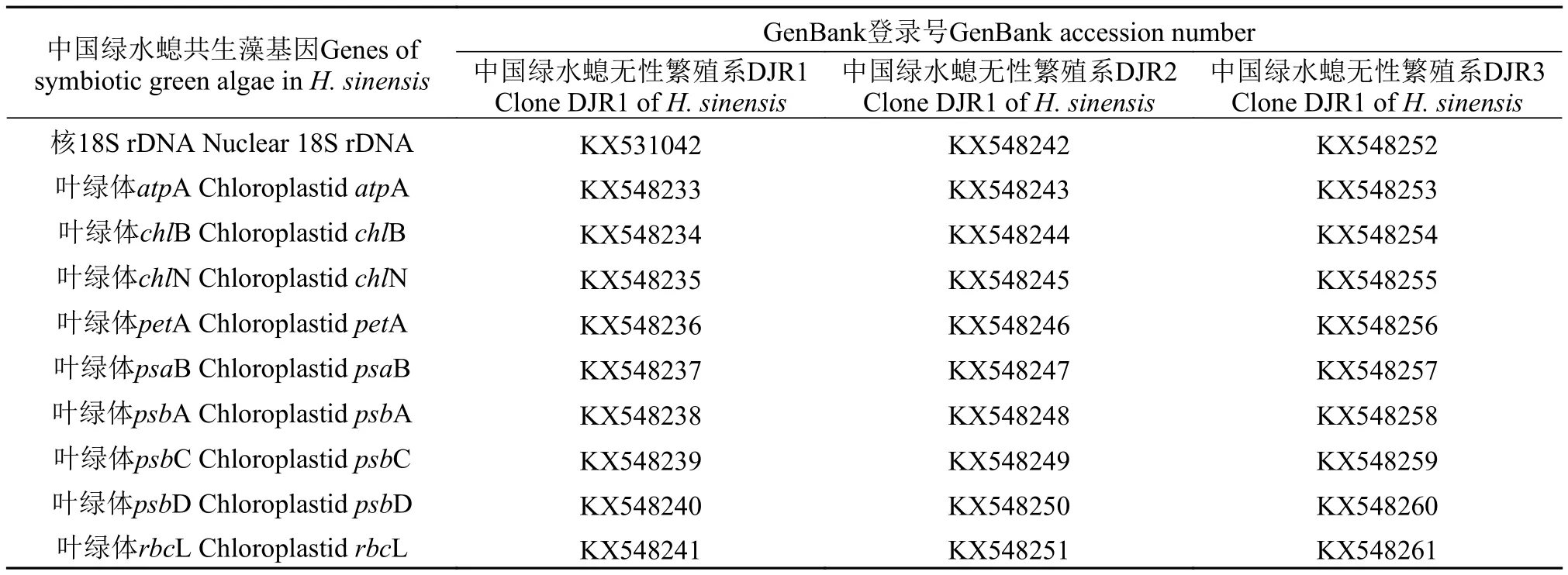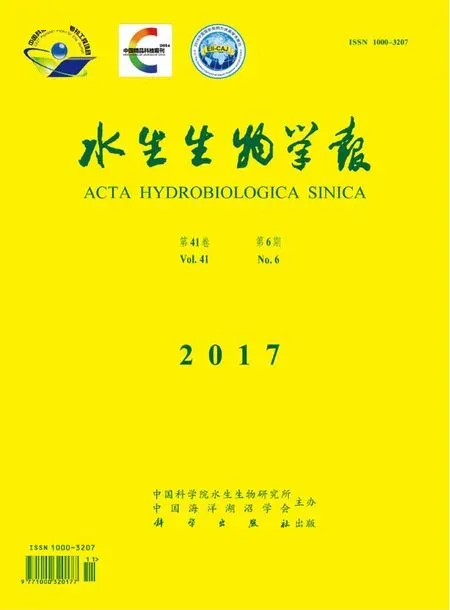基于核及叶绿体基因序列探讨中国绿水螅共生单细胞绿藻系统发生地位
陈磊磊 刘俊红 李全发 董文芳 张 行 潘红春
(安徽师范大学生命科学学院, 重要生物资源保护与利用研究安徽省重点实验室, 生物环境与生态安全安徽省高校省级重点实验室, 芜湖 241000)
基于核及叶绿体基因序列探讨中国绿水螅共生单细胞绿藻系统发生地位
陈磊磊 刘俊红 李全发 董文芳 张 行 潘红春
(安徽师范大学生命科学学院, 重要生物资源保护与利用研究安徽省重点实验室, 生物环境与生态安全安徽省高校省级重点实验室, 芜湖 241000)
研究对中国绿水螅共生绿藻的核18S rRNA基因全长序列及其叶绿体9个基因(atpA、chlB、chlN、petA、psaB、psbA、psbC、psbD及rbcL)片段序列进行了克隆和测序, 并基于18S rRNA基因序列及叶绿体9个基因序列的整合数据分别通过最大似然法(Maximum-likelihood)和贝叶斯分析(Bayesian inference)对中国绿水螅(Hydra sinensis)共生单细胞绿藻的系统发生地位进行了探讨。系统发生表明: (1)中国绿水螅共生绿藻属于共球藻纲(Trebouxiophyceae)小球藻目(Chlorellales), 但不属于其中的小球藻属(Chlorella); (2)来源于草履虫、水螅、地衣及银杏的共生绿藻均在共球藻纲支系, 而来源于蛙类和蝾螈的共生绿藻属于绿藻纲(Chlorophyceae)支系。无论在共球藻纲支系还是在绿藻纲支系, 不同来源的共生藻并没有排他性地聚为单系群而在系统树中与其他自由生活的绿藻混杂排列, 来自不同宿主的共生绿藻没有共同起源。
中国绿水螅; 共生单细胞绿藻; 系统发生; 核18S rRNA基因; 叶绿体基因
绝大多数动物通过摄食微生物、植物或其他动物而获得能量, 但一些动物却与单细胞真核绿藻建立共生关系而获得能量补充[1—5], 即动物宿主细胞内共生一定数量的绿藻个体, 宿主为藻类提供CO2、含氮物质、矿物质、水及庇护所, 而绿藻利用光合作用为宿主提供碳水化合物、氨基酸和其他有机物营养[6,7]。这种共生关系是相互制约(1个动物细胞内的绿藻数量是有限度的, 同时宿主细胞又不伤害藻类)和互利互惠的, 其生物学意义非常明显[8—10], 但该类共生体的起源诱因和进化驱动、起源时间及进化机制目前仍未阐明。
到目前为止已发现6个类群的动物与单细胞真核绿藻发生共生关系: 原生动物门纤毛纲中的草履虫、小瓜子虫及聚缩虫等类群中均有与单细胞绿藻共生的物种[11—15]; 许多海绵动物体内多种类型的细胞内有绿藻共生[16,17]; 刺胞动物门的绿水螅体内仅在内胚层皮肌细胞中有绿藻共生[18,19], 而其他细胞内均无共生绿藻分布; 扁形动物门的绿涡虫(Castrada,Dalyelfia,Plwellocora和Typhloplana等属)身体微小(体长小于3 mm), 共生绿藻在其各处组织细胞中均有分布[20]; 软体动物门瓣鳃纲的一些物种的鳃组织和外套膜组织细胞内有单细胞绿藻共生其中[21]; 脊索动物门两栖纲的一些蝾螈和蛙类的卵膜和早期胚胎中分布有单细胞共生绿藻[22]。
在动物细胞和绿藻的共生关系中, 动物细胞为宿主, 共生绿藻在进化上是后来进入动物细胞的[11],因此共生绿藻起源和进化机制的相关研究可能有助于动物-绿藻共生体起源机制的探讨。鉴于自由生活的单细胞绿藻高度多样性和传统分类学上的复杂性和低区分度、GenBank上自由生活的单细胞绿藻分子数据丰富以及共生绿藻最早来源于自由生活的单细胞绿藻这3个前提, 基于分子数据研究共生绿藻的起源和进化在当前可能不失为一种较为实际和行之有效的选择。中国绿水螅(Hydra sine-nsis)体内共生的单细胞绿藻尚未鉴定和定种[19,23],因此本研究通过核及叶绿体基因标记对中国绿水螅共生绿藻的系统发生地位进行了探讨, 为中国绿水螅共生绿藻的确切定种提供线索和基础资料。
1 材料与方法
1.1 实验材料
实验材料中国绿水螅(Hydra sinensis)(图1)采集于广东省惠州市东江流域, 从野外采集的水螅活体标本中选取3只个体单独培养, 据此建立3个中国绿水螅单克隆无性繁殖系(分别命名为DJR1、DJR2及DJR3, 原种采集地经纬度分别为113°9′E,23°09′N; 114°45′E, 23°13′N; 115°25′E, 24°11′N)。每天用丰年虫(Artemiasp.)幼虫喂食水螅1次, 喂食后及时更换培养液。水螅培养液由冷却后充氧的一蒸水配制(配方为: 1 mmol/L NaCl, 1 mmol/L CaCl2, 1 mmol/L KCl, 0.1 mmol/L MgSO4, 1 mmol/L Tris, pH 7.4)。中国绿水螅单克隆无性繁殖系长期保持在培养条件稳定的光照培养箱内[温度(25±0.5)℃, 光照度2000 lx, 光周期亮暗比12h∶12h]。
1.2 共生绿藻的分离和纯化

图1 中国绿水螅及其共生绿藻Fig. 1 Hydra sinensis and its symbiotic green algae
在Mcauley方法[24]基础上稍作修改从中国绿水螅中分离和纯化共生绿藻。具体步骤如下: (1)活体水螅用去离子水洗3遍后, 在1 mL去离子水中匀浆,500 r/min速度离心5min; (2)丢弃上清, 沉淀用0.5%SDS重悬, 500 r/min速度离心5min; (3)丢弃上清, 沉淀用0.5% SDS重悬, 2500 r/min速度离心5min;(4)丢弃上清, 沉淀用去离子水重悬, 2500 r/min速度离心5min; (5)收集绿藻沉淀备用。
1.3 共生绿藻总DNA的抽提
把适量的绿藻移入1.5 mL Eppendorf管中,加入800 μL在65℃水浴预热的CTAB提取缓冲液(100 mmol/L Tris-HCl pH 8.0, 20 mmol/L EDTA-2Na, 1.4 mol/L NaCl, 2% CTAB, 使用前加入0.1%(v/v)的β-巯基乙醇)并混匀, 每隔5min轻轻震荡几次, 20min后12000 r/min室温离心15min; 小心吸取上清液, 加入800 μL酚: 氯仿(体积比1∶1)溶液, 混匀; 12000 r/min 4℃离心10min; 小心吸取上清液,加入800 μL氯仿, 混匀, 12000 r/min 4℃离心10min;取上清, –20℃沉淀1h后, 12000 r/min 4℃离心10min; 弃去上清液, 用70%乙醇洗涤沉淀2次。沉淀用冷冻干燥机干燥后溶于50 μL去离子水中,–40℃保存备用。
1.4 共生绿藻核18S rRNA基因及叶绿体基因的克隆和测序
通过对单细胞绿藻核18S rRNA基因及叶绿体基因相关数据进行生物信息学分析, 筛选这些基因的序列保守性区段, 据此设计了一系列引物用于中国绿水螅共生绿藻核18S rRNA基因及叶绿体基因的PCR扩增及测序(表1)。本实验所有PCR反应的总反应体积均为50 μL, 其中含10×buffer 5.0 μL,25 mmol/L MgCl26.0 μL, 2.5 mmol/L dNTP 1.2 μL,引物(10 μmol/L)各1 μL,TaqDNA聚合酶1.2 μL(TaKaRa, 5 U/μL), DNA模板6 ng, 使用灭菌去离子水将反应总体积补至50 μL。反应体系在94℃预变性5min, 然后进入如下循环: 94℃变性30s, 45℃退火30s, 72℃延伸60s, 循环次数为35, 循环结束后再72℃延伸8min。扩增产物经1.0%琼脂糖凝胶电泳,然后在凝胶成像系统上检测。PCR产物首先经切胶纯化后与pMD18-T克隆载体连接, 连接液转化E.coliJM109菌株。菌落PCR方法筛选阳性克隆, 阳性克隆送往上海生工生物工程技术服务有限公司进行双向测序。
1.5 生物信息学分析
将测序得到的中国绿水螅共生绿藻核18S rRNA基因及叶绿体基因核酸序列在NCBI网站分别进行核酸序列BLAST在线分析, 获得相应的同源序列;再将共生绿藻核18S rRNA基因及叶绿体基因核酸序列分别与其同源核酸序列数据通过Clustal 1.8软件进行比对。

表1 本文所用引物序列Tab. 1 Sequences of primers used in the present study
基于核18S rRNA基因序列数据进行分子系统发生分析时, 内群包括不同来源的共生绿藻的26个同源序列、共球藻纲(Trebouxiophyceae)的12个同源序列及绿藻纲(Chlorophyceae)的15个同源序列,外群为来自石莼纲(Ulvophyceae)的1个同源序列。使用Modeltest 3.7检验序列数据并选择合适的建树参数模型[25]。通过PAUP 4.0b10软件[26], 基于HKY+G模型用最大似然法(Maximum-likelihood, ML)重建分子系统发生树。ML系统发生树中各节点的置信度由全部运算1000次自引导法重复检验。另外,使用MrBayes 3.2.3软件[27], 基于HKY+G模型并同时启动4条马尔可夫链(包括冷链1条, 热链3条)。以随机树为起始树, 运行3×106代, 每100代对系统树进行重新取样构建贝叶斯树(Bayesian inference tree, BI), 系统发生树各节点的置信度通过后验概率(Posterior probability, PP)检测。
把9个叶绿体基因核酸序列串联成整合数据用于分子系统发生分析, 串联顺序为:atpA-chlB-chlN-petA-psaB-psbA-psbC-psbD-rbcL。基于9个叶绿体基因核酸序列整合数据进行分子系统发生分析时, 内群为3个中国绿水螅单克隆无性繁殖系共生绿藻各自的叶绿体9个基因核酸序列整合数据及共球藻纲33个物种叶绿体的同源序列, 外群为银杏(Ginkgo biloba)叶绿体的同源序列。在基于9个叶绿体基因核酸序列整合数据重建系统发生树前,首先采用modeltest 3.7计算出每个基因的最适模型[25]。通过PAUP 4.0b10软件[26], 分别设置每个基因的最适模型后重建ML树。使用MrBayes 3.2.3软件[27], 亦分别设置每个基因的最适模型后重建BI树,运算时马尔可夫链运行了5×106代。
2 结果
2.1 共生绿藻核18S rRNA基因序列及系统发生分析
中国绿水螅3个单克隆无性繁殖系的共生绿藻核18S rRNA基因序列数据已提交GenBank(表2),把它们与其他51个同源序列数据进行分析比对后共有2076个碱基位点, 其中891个变异位点和585个简约信息位点(Parsimony informative site)。基于18S rRNA基因序列重建的ML树和BI树(图2)表明,共球藻纲自由生活的绿藻物种与来源于草履虫、水螅、地衣及银杏的共生绿藻聚成一单系群, 而绿藻纲自由生活的绿藻物种与来源于蛙类和蝾螈的共生绿藻聚成另外一个单系群。中国绿水螅共生绿藻的3个18S rRNA基因序列位于共球藻纲单系群内部, 并且在共球藻纲单系群中水螅共生绿藻、草履虫共生绿藻、银杏共生绿藻及地衣共生绿藻与自由生活的绿藻物种混杂排列, 即这些来源不同的共生绿藻并没有聚成一单系支。其中, 来自不同地区的绿水螅共生绿藻分为4个小支系, 而这4个小支系分别位于共球藻纲支系拓扑结构的不同位置, 被自由生活的绿藻物种隔开而没有聚成单系支(图2)。另外, 绿藻纲支系中来自两栖纲动物的共生藻也没有聚成单独一支, 而是与绿藻纲的一些自由生活的绿藻物种混杂排列(图2)。
2.2 共生绿藻叶绿体9个蛋白质编码基因序列及系统发生分析
中国绿水螅3个单克隆无性繁殖系的共生绿藻叶绿体9个蛋白质编码基因序列数据已提交Gen-Bank(表2)。中国绿水螅共生绿藻叶绿体9个基因核酸序列串联整合数据与其他34个物种叶绿体同源序列比对后序列总长度为10106个核苷酸位点,其中有5449个变异位点和4533个信息简约位点。基于叶绿体9个基因核酸序列串联整合数据的系统发生分析结果表明(图3), 中国绿水螅3个单克隆无性繁殖系的共生绿藻位于共球藻纲的小球藻目(Chlorellales)单系群内部。中国绿水螅共生绿藻与类小球藻属(Parachlorella)及双月藻属(Dicloster)组成的单系群聚为一支, 而没有直接与小球藻属(Chlorella)相聚(图3)。

表2 本文测定的基因序列Tab. 2 Gene sequences determinated in the present study
3 讨论
目前把在真核生物细胞内共生的单细胞绿藻暂归类于球状绿藻类群(Coccoid green algae)[28,29]。而目前许多证据表明球状绿藻类群可能仅是一个庞杂的形态学类群(Morphological group), 而非有共同起源的自然类群(Natural group)[30]。这首先源于球状绿藻类群中的绝大多数物种进行无性繁殖、而未见有性生殖, 因而在这个类群通过杂交实验利用生殖隔离原理区分其中不同的生物学物种难以实现; 其次球状绿藻类群形态学特征在不同物种之间的低区分度更增加了该类群基于形态学特征分类实践的难度[30]。幸好分子数据的介入在一定程度上为厘清球状绿藻类群分类体系起到了至关重要的作用, 基于分子数据的分析表明球状绿藻类群除了主要涉及绿藻门共球藻纲、绿藻纲及葱绿藻纲(Prasinophyceae)中的部分物种外, 还涉及轮藻门(Charophyta)绿叠球藻纲(Chlorokybophyceae)和双星藻纲(Zygnemophyceae)中的少数物种[31—33]。
为探讨中国绿水螅共生绿藻系统发生地位, 我们搜集了GenBank中所有不同来源的共生单细胞绿藻的18S rRNA基因序列, 对这些序列进行初步分析后发现它们与绿藻门共球藻纲或绿藻纲物种同源序列的相似性较高。基于此, 本研究在共球藻纲和绿藻纲中分别选择了一些自由生活的单细胞绿藻的18S rRNA基因序列与中国绿水螅共生绿藻及不同来源的共生单细胞绿藻的同源基因序列一起进行分子系统发生分析(图2)。结果表明, 共球藻纲自由生活的绿藻物种与来源于草履虫、水螅、地衣及银杏的共生绿藻聚成一单系群, 而绿藻纲自由生活的绿藻物种与来源于蛙类和蝾螈的共生绿藻聚成另外一个单系群。无论在共球藻纲支系还是在绿藻纲支系, 不同来源的共生藻并没有排他性地聚为单系群、而在系统树中与其他自由生活的绿藻混杂排列, 来自不同宿主的共生绿藻没有共同起源(图2)。
这个特殊的进化现象可能源于以下2种假设的其中之一: 第一种假设是单细胞绿藻一开始可能全部为自由生活的种类, 而这个类群的进化和演变肯定遵循普遍的进化规律。可能是宿主(称潜在宿主最为合适)以单细胞绿藻为食、或在摄食时绿藻经常混入食物、或绿藻在潜在宿主体表长期外共生、或绿藻与潜在宿主长期共栖等诸多特殊因素最终导致了绿藻与宿主的内共生关系。而内共生关系建立前绿藻和潜在宿主的关系是非常随机的,源于绿藻的多样性以及潜在宿主的多样性; 而内共生关系一旦建立, 共生绿藻和宿主的关系又是高度专一的, 因为某个宿主体内的共生绿藻自然转移到其他宿主体内的可能性非常低。简言之, 好比单细胞绿藻进化路线网是一棵盘根错节的大树, 绿藻-宿主共生关系是在不同的末端树叶上发生的。也就是说, 在一定意义上讲探寻不同的绿藻-宿主共生体共生绿藻的共同起源相关命题的本身就是不可能有结果的悖论。第二种假设是同一类型宿主的共生绿藻可能有一个共同起源, 但共生绿藻可能从宿主细胞“逃逸”出来重新回到自然界发展为自由生活的单细胞绿藻[34,35]。上述2个假设无论哪个是真的, 结果都一样, 就是共生单细胞绿藻和自由生活的单细胞绿藻在系统发生树上混杂排列。

图3 基于9个叶绿体蛋白质编码基因联合序列数据重建的共球藻纲ML树及BI树Fig. 3 Maximum likelihood tree and Bayesian inference tree of Class Trebouxiophyceae based on the combined sequences of nine chloroplast protein-coding genes
以往的研究把一些无脊椎动物体内的共生绿藻放在小球藻属(Chlorella)[36,37]。本研究基于叶绿体9个基因核酸序列串联整合数据重建的共球藻纲系统树显示中国绿水螅共生绿藻位于小球藻目支系(图3), 但中国绿水螅共生绿藻与该目的小球藻属物种没有直接相聚。无独有偶, 基于18S rRNA基因序列的系统发生树也表明中国绿水螅共生绿藻与小球藻属也没有直接相聚(图2)。看来, 中国绿水螅共生绿藻的确切定种还有待综合分子系统学、形态学及生理生态学等多方面证据综合考虑。
致谢:
感谢深圳大学生命与海洋科学学院汪安泰先生协助采集实验材料。
[1]Hoshina R, Kato Y, Kamako S,et al. Genetic evidence of“American” and “European” type symbiotic Algae ofParamecium bursariaEhrenberg [J].Plant Biology, 2005,7(5): 526—532
[2]Douglas A E. Symbiotic Interactions [M]. Oxford amp; New York: Oxford University Press Inc. 1994, 223—261
[3]Douglas A E, Huss V A R. On the characteristics and taxonomic position of symbioticChlorella[J].Archives of Microbiology, 1986, 145(1): 80—84
[4]Trench R K. Microalgal-Invertebrate symbioses: a review [J].Endocytobiosis amp; Cell Research, 1993, 135(9):135—175
[5]Kerney R, Kim E, Hangarter R P,et al. Intracellular invasion of green algae in a salamander host [J].Proceedings of the National Academy of Sciences of the United States of America, 2011, 108(16): 6497—6502
[6]Huss V A R, Holweg C, Kessler E,et al. There is an ecological basis for host/symbiont specificity inChlorella/Hydrasymbioses [J].Endocytobiosis amp; Cell Research,1993, 10(1—2): 35—46
[7]Huss V A R, Frank C, Hartmann E C,et al. Biochemical taxonomy and molecular phylogeny of the GenusChlorellasensu lato (Chlorophyta) [J].Journal of Phycology, 1999, 35(3): 587—598
[8]Krienitz L, Hegewald E, Hepperle D,et al. Phylogenetic relationship ofChlorellaandParachlorellagen. nov.(Chlorophyta, Trebouxiophyceae) [J].Phycologia, 2004,43(5): 529—542
[9]Huss V A R, Sogin M L. Phylogenetic position of someChlorellaspecies within the Chlorococcales based upon complete small-subunit ribosomal RNA sequences [J].Journal of Molecular Evolution, 1990, 31(5): 432—444
[10]Hoshina R, Kamako S, Imamura N. Phylogenetic position of endosymbiotic green algae inParamecium bursariaEhrenberg from Japan [J].Plant Biology, 2004,6(4): 447—453
[11]Hoshina R, Imamura1 N. Multiple origins of the symbioses inParamecium bursaria[J].Protist, 2008, 159(1):5—63
[12]Kodama Y, Fujishima M. Endosymbiosis ofChlorellaspecies to the ciliateParamecium bursariaalters the distribution of the host’s trichocysts beneath the host cell cortex [J].Protoplasma, 2011, 248(2): 325—337
[13]Kodama Y, Inouyea I, Fujishima M. SymbioticChlorellavulgaris of the ciliateParamecium bursariaplays an important role in maintaining perialgal vacuole membrane functions [J].Protist, 2011, 162(2): 288—303
[14]Stabell R, Andersen T, Klaveness D. Ecological significance of endosymbionts in a mixotrophic ciliate - an experimental test of a simple model of growth coordination between host and symbiont [J].Journal of Plankton Research, 2002, 24(9): 889—899
[15]Queimalinos C P, Modenutti B E, Balseiro E G. Symbiotic association of the ciliateOphrydium naumanniwithChlorellacausing a deep chlorophyll a maximum in an oligotrophic South Andes lake [J].Journal of Plankton Research, 1999, 21(1): 167—178
[16]Bil K, Titlyanov E, Berner T. Some aspects of the physiology and biochemistry ofLubomirska baikalensis,a sponge from Lake Baikal containing symbiotic algae[J].Symbiosis, 1999, 26(2): 179—191
[17]Frost T, Graham L, Elias J. A yellow-green algal symbiont in the freshwater sponge,Corvomeyenia everetti:convergent evolution of symbiotic associations [J].Freshwater Biology, 2003, 38(2): 395—399
[18]Belda-Baillie C A, Baillie B K, Maruyama T. Specificity of a model cnidarian–dinoflagellate symbiosis [J].Biological Bulletin, 2002, 202(1): 74—85
[19]Wang A T, Deng L, Lai J Q,et al. A new species of green hydra (Hydrozoa: Hydrida) from China [J].Zoological Science, 2009, 26(9): 664—668
[20]Douglas A E. Experimental studies on symbioticChlorellain the neorhabdocoel turbellariaDalyellia viridisandTyphloplana viridata[J].British Phycological Journal, 1987, 22(2): 157—161
[21]Pardy R L. Symbiotic algae and14C incorporation in the freshwater clam,Anodonta[J].Biological Bulletin, 1980,158(3): 349—355
[22]Kim E, Lin Y, Kerney R,et al. Phylogenetic analysis of algal symbionts associated with four north american amphibian egg masses [J].PLoS One, 2014, 9(11): e108915
[23]Pan H C, Qian X C, Li P,et al. The complete mitochondrial genome of Chinese green hydra,Hydra sinensis(Hydroida: Hydridae) [J].Mitochondrial DNA, 2014,25(1): 44—45
[24]Mcauley P J. Ammonium metabolism in the green hydra symbiosis [J].The Biological Bulletin, 1995, 188(1):210—218
[25]Posada D, Buckley T R. Model selection and model averaging in phylogenetics: advantages of akaike information criterion and bayesian approaches over likelihood ratio tests [J].Systematic Biology, 2004, 53(5): 793—808
[26]Jeon H K, Park H, Lee D,et al. Molecular detection ofSpirometra decipiensin the United States [J].The Korean Journal of Parasitology, 2016, 54(4): 503—507
[27]Ronquist F, Teslenko M, van der Mark P,et al. MrBayes 3.2: efficient Bayesian phylogenetic inference and model choice across a large model space [J].Systematic Biology,2012, 61(3): 539—542
[28]Takeda H. Sugar composition of the cell wall and the taxonomy ofchlorella(chlorophyceae) [J].Journal of Phyco-logy, 1991, 27(2): 224—232
[29]Pröschold T, Darienko T, Silva P C,et al. The systematics ofZoochlorellarevisited employing an integrative approach [J].Environmental Microbiology, 2011, 13(2):350—364
[30]Krienitz L, Bock C. Present state of the systematics of planktonic coccoid green algae of inland waters [J].Hydrobiologia, 2012, 698(1): 295—326
[31]Bock C, Krienitz L, Pröschold T. Taxonomic reassessment of the genusChlorella(Trebouxiophyceae) using molecular signatures (barcodes), including description of seven new species [J].Fottea, 2011, 11(2): 293—312
[32]Leliaert F, Smith D R, Moreau H,et al. Phylogeny and molecular evolution of the green algae [J].Critical Reviews in Plant Sciences, 2012, 31(1): 1—46
[33]Darienko T, Gustavs L, Eggert A,et al. Evaluating the species boundaries of green microalgae (Coccomyxa, Trebouxiophyceae, Chlorophyta) using integrative taxonomy and DNA barcoding with further implications for the species identification in environmental samples [J].PLoS One, 2015, 10(6): e0127838
[34]Fishman Y, Zlotkin E, Sher D. Expulsion of symbiotic algae during feeding by the green hydra-a mechanism for regulating symbiont density [J]?PLoS One, 2008, 3(7):e2603
[35]Kawaida H, Ohba K, Koutake Y,et al. Symbiosis between hydra and chlorella: molecular phylogenetic analysis and experimental study provide insight into its origin and evolution [J].Molecular Phylogenetics and Evolution, 2013, 66(3): 906—914
[36]Krienitz L, Huss V A R, Bock C.Chlorella: 125 years of the green survivalist [J].Trends in Plant Science, 2015,20(2): 67—69
[37]Reisser W. The taxonomy of green algae endosymbiotic in ciliates and sponges [J].British Phycological Journal,1984, 19(4): 309—318
THE SIGNIFICANCE OF PHYLOGENETIC OF UNICELLULAR GREEN ALGAE ENDOSYMBIOTIC IN HYDRA SINENSIS INFERRED FROM NUCLEAR AND CHLOROPLAST GENE SEQUENCES
CHEN Lei-Lei, LIU Jun-Hong, LI Quan-Fa, DONG Wen-Fang, ZHANG Hang and PAN Hong-Chun
(Provincial Key Laboratory of the Conservation and Exploitation of Biological Resources in Anhui, Provincial Key Laboratory of Biotic Environment and Ecological Safety in Anhui, College of Life Sciences, Anhui Normal University, Wuhu 241000, China)
In the fields of evolutionary ecology, evolutionary biology and cell biology, symbiosis betweenHydra sinensisand single-celled green algae is a special biological phenomenon with high scientific value. Although the biological significance of hydra-algea has been understood, its origin and evolutionary mechanism are still unclear by now. In the hydra-algae symbiosis status, free living algae goes into its host cell during evolution, so the study on the origin of symbiotic algae can help understand the mechanism of hydra-algae symbiosis. In this study, 18S rRNA gene sequences in nucleolus and nine protein-coding genes (atpA,chlB,chlN,petA,psaB,psbA,psbC,psbD andrbcL) in chloroplast were cloned and sequenced from the symbiotic green algae inH. sinensis. With the application of Maximum Likelihood (ML) and Bayesian analysis methods, the significance of phylogenetic of the unicellular green algae endosymbiotic inH. sinensiswas examined. The results show that the endosymbiotic green alga are belong to Chlorellales, Trebouxiophyceae, instead of Chlorellal; the green alga in paramecium, hydra, lichen and ginkgo are belong to Trebouxiophyceae, whereas others from frog and salamander are in Chlorophyceae. However, these two groups of endosymbiotic alga could live in the same host without forming a monophyletic group. In addition, endosymbiotic alga from different host cells have different origins.
Hydra sinensis; Symbiotic unicellular green algae; Phylogeny; Nuclear 18S rRNA gene; Chloroplast gene
Q959.131; Q949.2
A
1000-3207(2017)06-1265-08
2016-09-05;
2017-04-10
国家自然科学基金(31370406和31671529)资助 [Supported by the National Natural Science Foundation of China (31370406,31671529)]
陈磊磊(1991—), 男, 安徽蚌埠人; 硕士研究生; 主要研究方向为动物分子生物学。E-mail: chenleileiwjc@sina.com
潘红春(1969—), 男, 教授; 主要研究方向为水螅发育与共生的细胞及分子机理。E-mail: panhongchun@126.com
10.7541/2016.157

